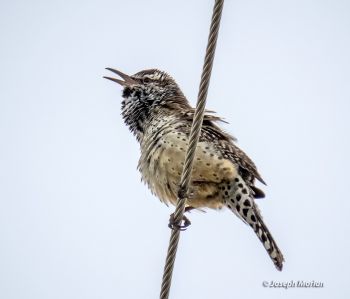- Campylorhynchus brunneicapillus
Identification
L. 7-8 1/4 in (18-21 cm)
- Starling sized wren
- Spotted underparts
- White eyebrows
- Rusty crown
- White spots on outer tail feathers
Distribution
Resident from southern California, southern Nevada, Utah, and western Texas southward to Mexico.
Taxonomy

Photo © by Joseph Morlan
Uvalde, Texas, USA, 17 April 2021
Subspecies[1]
There are 8 subspecies:
- C. b. anthonyi (couesi):
- Arid south-western US to northern Baja California, north-western Mexico and extreme northern Tamaulipas
- C. b. sandiegensis:
- Arid San Diego County (southern California) and adjacent north-western Baja
- C. b. brunneicapillus bryanti:
- Pacific slope of western Baja California between 31º and 29º 30'N
- C. b. purus:
- Coastal central Baja California between 29º and 25ºN
- C. b. seri:
- Isla Tiburón (Sea of Cortés)
- C. b. affinis:
- Southern Baja California (south of 25º N to Cabo San Lucas)
- C. b. brunneicapillus:
- North-western Mexico (central Sonora to northern Sinaloa)
- C. b.s guttatus:
Habitat
Arid and semi arid desert.
Behaviour
Diet
The diet includes ants, beetles, grasshoppers, wasps, seeds and fruits.
Breeding
Both sexes build a football-shaped nest of dry grasses lined with feathers, with a small side entrance, placed in cactus plants. The clutch consists of 4-5 buff, speckled brown, eggs which are incubated by the female for 16 days. The male continues to build more nests for roosting and nesting sites. Both parents care for the young, who fledge in 19-23 days.
Vocalisation
Rapid, mechanical chug-chug-chug-chug-chug.
In Culture
State Bird of Arizona.
References
- Clements, JF. 2008. The Clements Checklist of Birds of the World. 6th ed., with updates to December 2008. Ithaca: Cornell Univ. Press. ISBN 978-0801445019.
- blueplanetbiomes
Recommended Citation
- BirdForum Opus contributors. (2025) Cactus Wren. In: BirdForum, the forum for wild birds and birding. Retrieved 9 May 2025 from https://www.birdforum.net/opus/Cactus_Wren
External Links
GSearch checked for 2020 platform.1





